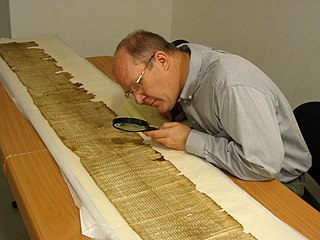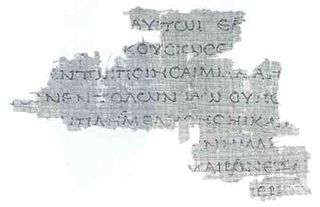Related Research Articles

The Dead Sea Scrolls are ancient Jewish and Hebrew religious manuscripts discovered between 1946 and 1956 at the Qumran Caves in what was then Mandatory Palestine, near Ein Feshkha in the West Bank, on the northern shore of the Dead Sea. Dating from the 3rd century BCE to the 1st century CE, the Dead Sea Scrolls are considered to be a keystone in the history of archaeology with great historical, religious, and linguistic significance because they include the oldest surviving manuscripts of entire books later included in the biblical canons, along with deuterocanonical and extra-biblical manuscripts which preserve evidence of the diversity of religious thought in late Second Temple Judaism. At the same time they cast new light on the emergence of Christianity and of Rabbinic Judaism. Most of the scrolls are held by Israel in the Shrine of the Book at the Israel Museum, but their ownership is disputed by Jordan due to the Qumran Caves' history: following the End of the British Mandate for Palestine in 1947, Jordan occupied the area in the 1948 Arab–Israeli War, and Israel captured both the area and several Scrolls from Jordan in the 1967 Six Day War. However, some of the scrolls are still in Jordan and are now displayed at The Jordan Museum in Amman. Ownership of the scrolls is also contested by the State of Palestine.
Emanuel Tov, is a Dutch–Israeli biblical scholar and linguist, emeritus J. L. Magnes Professor of Bible Studies in the Department of Bible at the Hebrew University of Jerusalem. He has been intimately involved with the Dead Sea Scrolls for many decades, and from 1991, he was appointed Editor-in-Chief of the Dead Sea Scrolls Publication Project.
4Q108 is a fragment containing a portion of the Song of Songs (3:7–8) in Hebrew. Fragments from three such scrolls were found in Cave 4 at Qumran. These, and 6Q6 from Cave 6, estimated from 2nd century BCE, comprise the total witness to the Song from the Dead Sea Scrolls, known so far.

4QMMT, also known as MMT, or the Halakhic Letter, is a reconstructed text from manuscripts that were part of the Dead Sea Scrolls discovered at Qumran in the Judean desert. The manuscripts that were used to reconstruct 4QMMT were found in Cave 4 at Qumran between the years 1953 and 1959. They were kept at the Palestinian Archaeological Museum, now known as the Rockefeller Museum in Jerusalem.
Discoveries in the Judaean Desert (DJD) is the official 40-volume publication that serves as the editio princeps for the Dead Sea Scrolls. It is published by Oxford University Press.
6Q6 is a small portion of a scroll from Cave 6 at Qumran, containing Song of Songs 1:1-7 in Hebrew. Together with three scroll portions found in Cave 4, they comprise the total witness to the Song from the Dead Sea Scrolls. It is dated to about 50 CE.

Donald W. Parry Ph.D. is a professor of Hebrew Bible in the Department of Asian and Near Eastern Languages at Brigham Young University. He holds the Abraham O. Smoot Professorship. He is the author and editor of many works related to the Dead Sea Scrolls and the Hebrew Bible, Old Testament. He has been a member of the International Team of Translators of the Dead Sea Scrolls since January 1994. He served as a member of the Dead Sea Scrolls Foundation Board of Advisors, 2008–present and presently serves as a member of the Dead Sea Scrolls Foundation Board of Trustees.
The Nahum Commentary or Pesher Nahum, labelled 4QpNah or 4Q169, was among the Dead Sea Scrolls in cave 4 of Qumran that was discovered in August 1952. The editio princeps of the text is to be found in DJD V., edited by John Allegro. The text is described thus: 'one of the "continuous pesharim" from Qumran, successive verses from the biblical Book of Nahum are interpreted as reflecting historical realities of the 1st century BCE."
4Q510–511, also given the title Songs of the Sage or Songs of the Maskil, is a fragmentary Hebrew-language manuscript of a Jewish magical text of incantation and exorcism in the Dead Sea Scrolls, specifically for protection against a list of demons. It is notable for containing the first clear usage of the Hebrew term lilith in relation to a supernatural creature. It is comparable to Aramaic incantation 4Q560 and also 11Q11.
4Q41 or 4QDeuteronomyn, also known as the All Souls Deuteronomy, is a Hebrew Bible manuscript from the first century BC containing two passages from the Book of Deuteronomy. Discovered in 1952 in a cave at Qumran, near the Dead Sea, it preserves the oldest existing copy of the Ten Commandments.

The manuscript 4Q120 is a Septuagint manuscript (LXX) of the biblical Book of Leviticus written on papyrus, found at Qumran. The Rahlfs-No. is 802. Palaoegraphycally it dates from the first century BCE. Currently the manuscript is housed in the Rockefeller Museum in Jerusalem.

The Greek Minor Prophets Scroll from Nahal Hever is a Greek manuscript of a revision of the Septuagint dated to the 1st century CE. The manuscript is kept in the Rockefeller Museum in Jerusalem. It was first published by Dominique Barthélemy in 1963. The Rahlfs-Siglum is 943.

Paleo-Hebrew Leviticus Scroll, known also as 11QpaleoLev, is an ancient text preserved in one of the Qumran group of caves, and which provides a rare glimpse of the script used formerly by the Israelites in writing Torah scrolls during pre-exilic history. The fragmentary remains of the Torah scroll is written in the Paleo-Hebrew script and was found stashed away in cave no. 11 at Qumran, showing a portion of Leviticus. The scroll is thought to have been penned by the scribe between the late 2nd century BCE to early 1st century BCE, while others place its writing in the 1st century CE.
References
- ↑ Ulrich, Eugene, ed. (2010). The Biblical Qumran Scrolls: Transcriptions and Textual Variants. Brill. pp. 741–744. ISBN 9789004181830 . Retrieved May 15, 2017.
- ↑ Dead sea scrolls - Song of Songs.
- ↑ Fitzmyer, Joseph A. (2008). A Guide to the Dead Sea Scrolls and Related Literature. Grand Rapids, MI: William B. Eerdmans Publishing Company. p. 42. ISBN 9780802862419 . Retrieved February 15, 2019.
- ↑ Discoveries in the Judaean Desert XVIII, p. 199.
- 1 2 DJD18: 199.
- ↑ DJD18: 202.
- 1 2 Florentino García Martínez, Eibert J. C. Tigchelaar. The Dead Sea Scrolls Study Edition: 1Q1-4Q273